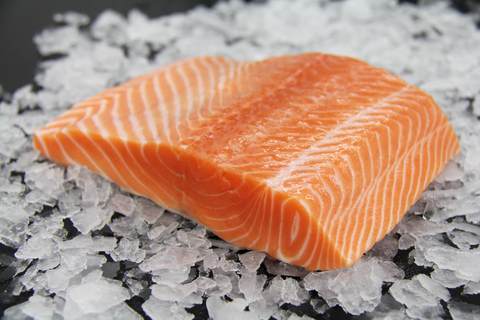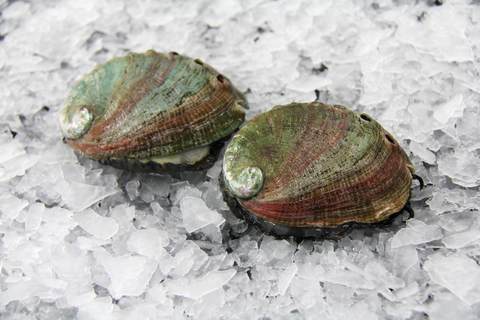We are reader supported. When you purchase through links on our site, we may earn an affiliate commission. Also, as an Amazon affiliate, we earn from qualifying purchases.

Sushi fans often dismay at the thought of spending a good amount of cash dining at a reputed sushi restaurant. But, the incessant cravings need a solution. Making sushi at home may be the answer but the poor souls give up the idea because they don’t know how to judge whether a fish is suitable for raw consumption.
My friends often call me up to ask ‘where to buy sushi grade fish’ so I decided to share my knowledge for all those who seek an answer. If you are lucky enough to live near the coastal region, you may buy them fresh as they are taken out of the sea and flash frozen. Others must look for sushi-grade fish (I will explain below) available at trusted fishmongers or source them from online fish markets.
Contents
Knowing The Risks Associated With Raw Fish

When talking about sourcing the highest quality sushi-grade fish that is suitable for raw consumption, it is important to understand the reasons why you wish to avoid regular fish. The two biggest threats that are destroyed through heat based cooking but may remain alive in raw fish are bacteria and parasites.
You may have heard about people having cramps or stomach aches after consuming raw fish at a shady sushi restaurant. These are signs of a sushi meal gone wrong and there are high chances that the raw fish was infected with bacteria.
However, don’t be fooled into believing that fish that is fresh out of the sea does not contain any bacteria or parasites. As soon as the fish is taken out of the sea, bacteria start thriving and thus the fishermen use an advanced technique called flash freezing to kill them.
Parasites such as anisakids and tapeworms can be destroyed completely through the process of flash freezing. However, the home freezer may not have the capacity to maintain an internal temperature of -18°C so it’s not a good idea to store a lot of raw fish at home.
At the sushi restaurants that serve raw fish in huge quantities, they usually have high capacity freezers that can store fish for several days. The FDA (Food and Drug Administration) has outlined the following regulation for complete parasite destruction.
Freeze fish at a -20°C (-4°F) or below the temperature for at least 168 hours (7 days)
Freeze fish at a -35°C (-31°F) or below the temperature for at least 15 hours
The farm-raised salmon and large-sized tuna are fed with parasite-free food in a controlled environment, hence they are exceptions. They do not require any flash freezing to get rid of parasites.
Related Article: What Kind Of Salmon Is Best For Sushi?
Understanding The Term ‘Sushi-Grade’
If you are new to sushi, it will be difficult for you to understand what is sushi-grade, so here’s some critical information to make things easier for you. During my research, I realized that most fishmongers are not aware of the FDA regulations regarding sushi-grade as they are not clearly stated.
As a result, the fishmongers and suppliers have established certain standards to flash freeze fish and seafood as soon as they are taken out of the water. In some restaurants, the chef may tell you that they use fresh fish for making sushi. However, this is technically incorrect.
They mostly use sushi-grade fish that has been thawed by the local fishmonger. The term ‘fresh’ is most commonly used as a selling point because people consider it to be superior to sushi-grade. However, it is essential to understand that fish that has not been frozen at all is unsafe for consumption.
So, even if you live near the coastal region, you will probably get fish that is flash frozen the moment it’s out of the water. In case of certain fish species, selling them without freezing beforehand is considered as an illegal act.
While sushi does not necessarily mean a raw fish delicacy, we cannot deny that this traditional food made eating raw seafood a trend across the world. If you wish to make your own sushi at home, you need to buy the highest quality fish that can be eaten raw.
The fish you see in the supermarket and grocery stores are usually not sushi-grade and they are not safe to be eaten raw. When in doubt, always ask your fishmonger to ensure that he buys from a reputed supplier who understands the meaning and consequences of sushi-grade.
Trusted Fishmonger Or Suppliers
You may ask your local fishmonger if they have sushi-grade fish that is safe to be eaten raw. In most cases, they will not have one immediately. However, if you tell them beforehand, they may be able to source some sushi-grade fish from their supplier, exclusively for you.
When purchasing raw fish or seafood from your local fishmonger, it is okay to believe him but I would suggest that you do the following tests to be doubly sure of the quality. Here are some tell-a-tale signs that reveal whether the raw fish is sushi grade or not.
The appearance
The flesh of the fish should be translucent and shiny, without any milky slime over it. If the outer skin has a dull appearance or looks slimy, it indicates that the fish is off. Tuna fish may sometimes be treated with gas to make them look brighter.
If the edges of the tuna look brownish, it’s a sign that the fish is not of optimum quality. You must also look at the eyes of the fish as they reveal the entire story. If the eyes are unclear and have a milky slime, the fish is probably too old.
The aroma
When it comes to the taste of raw fish, most beginners will expect it to be like the ocean or smell very fishy. However, it’s just the opposite. Sushi-grade fish actually has no smell at all. If the fish smells fishy when you bring it close to your nose, it is highly possible that the fish is not sushi-grade.
The feel
Sushi grade fish can be easily identified by its fresh and firm flesh. Press your finger against the flesh to see if it springs back. The not-so-fresh fish will have a dent on the flesh, while the sushi grade will immediately resume its shape.
Fish market

If you are lucky enough to live in a place where you have an Asian, specifically Japanese fish market near you then you are in for luck. Most of the authentic places import high-quality fish from the world famous Tsujiki market in Tokyo, Japan.
You will find sushi-grade fish of different varieties and sometimes they may be cleaned and cut into fillets to be used for sushi and sashimi. They may sometimes be cut in the shape of a rectangular block that you may further slice into the desired shape using a sharp Japanese knife.
Just make sure that the fish you buy is sushi-grade, intended to be eaten raw. You may request the fishmonger to pack your fish with some ice cubes to ensure that the fish remains frozen by the time you reach home.
As soon as you reach home, refrigerate the fish and try to eat it within 24 hours if you intend to consume it raw. If you don’t plan to eat it in the next 2 days, freeze it in a vacuum sealed bag. While thawing your fish, always keep it in the refrigerator overnight. Never attempt thawing at room temperature.
Grocery Store
In most cases, grocery stores will not store sushi-grade fish but there is no harm trying. Never assume that a fish is sushi-grade by simply looking at it. If the fish is not labeled as sashimi-grade or sushi-grade, always ask the store representatives.
Even if they are labeled so, you may ask educated questions like ‘Was the fish frozen as per FDA guidelines to eliminate the risk of bacteria and parasites?’ If you can find a grocer that you can trust to buy sushi-grade fish then you are lucky. If the grocer is situated close to the coast, this is a possibility.
However, if you ask me, I would prefer to buy sushi-grade fish only from the fishmonger I trust or some a reliable online store.
Online Fish Store
In my so many years of experience, I have learned that buying sushi-grade fish from an online store is always safer if you don’t live close to the sea. I certainly prefer this option over the local grocer because, with a trusted source, you can be sure that the fish is properly handled, stored and shipped to you.
The online store bought fish is typically a couple of days old when shipped and the shipments are done overnight. While the shipping cost for sushi-grade fish bought online is high, it is worth the quality and speed at which the order is delivered at your doorstep. The difference is no more than a good tip you would willingly pay at a good quality sushi bar.
With the rising popularity of sushi and the great demand for sushi-grade fish, several online stores have come up but my favorite is Catalina Offshore Products. I prefer the online store for its incredible selection of raw fish and seafood for making sushi at home.

The store also stocks some of the rare to find sushi-grade delicacies such as uni (sea urchin), ankimo (monkfish liver), and awabi (abalone). Most of the products are shipped frozen to you so you may defrost when you are ready to make sushi at home.
If you are a beginner at sushi making, you may also find sushi kits and other essential ingredients required to help you get started. Several online fish stores have come and fizzled out from the market because it is tough to sustain in this market. However, Catalina has stood the tests of time and I now recommend it to all those who ask me where to buy sushi grade fish.
Straight Out Of The Ocean
If you are lucky enough to catch a saltwater fish when you are out for leisure fishing, you may use it for making sushi. However, there’s no guarantee that your fresh catch is parasite free so your health may still be at risk. I would suggest that you avoid risking your health for a little adventure.
The Internet has made life easier and you can now order perfectly frozen fish shipped to your address. If you wish to make sushi at home, order sushi-grade fish from a reputed online store and prepare sushi rice at home. Add a few veggies like avocado or cucumber of your choice and you can have delicious sushi ready to enjoy.
Smart Buying Strategies To Choose Sushi Grade Fish
Pick the low-risk species
When in doubt, it is always better to play safe and choose Arctic char instead of salmon, sea bream in the place of flounder and tuna fish. Avoid buying the high-risk species such as wild salmon, cod, and mackerel unless they are especially frozen as per FDA regulations to kill parasites.
Be good friends with your local sushi chef
If you have a reputed sushi restaurant in your area, try to befriend the sushi chef because they purchase sushi-grade fish in bulk quantity from trusted suppliers. His years of experience can help him tell sushi-grade fish from an ordinary one. If you have a good relationship with the chef, he may order some extra raw fish for you to make sushi at home.
Choose the farmed fish over the wild
The wild fish caught from the ocean has an amazing taste, which is superior to any other variety. However, they may have a high risk of parasites and bacteria. The farmed fish may not be entirely immune but they have a significantly lower risk because they feed on pellets instead of any wild prey that may be infected.
Candle-test the fillets
When filleting the raw fish, try out the candle test to look for parasites in the flesh. You may not like this process but it is always better to pick out the worms rather than ingesting them. When held up to light, you can see the white worms moving freely or coiled up.
Please note that the candeling method cannot make your fish 100% parasite-free. It can only confirm that it’s there and needs to be grilled or roasted before eating.
Related Questions
Is the grocery store fish safe to use in sushi?
If the grocery store is close to the coastal area and they buy flash frozen fish then yes. Otherwise, it is generally not a good idea to get your sushi-grade fish from the grocer’s.
What’s the taste of raw fish?
Raw tuna has a mild taste while raw salmon has a buttery flavour to it. When fresh, raw fish will not have any fishy smell. If the flesh stinks or looks slimy, you must give it a pass.
Is it safe to buy fish online?
Of course. The sites follow FDA regulation to sell sushi-grade fish for raw consumption. Packing and shipping are done with great care to ensure that you get the best quality delivered to your home.

